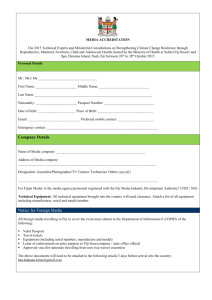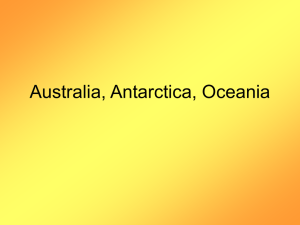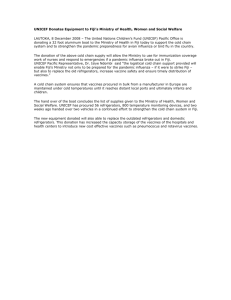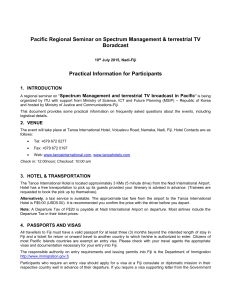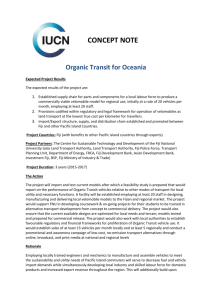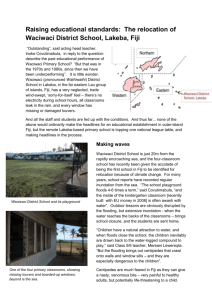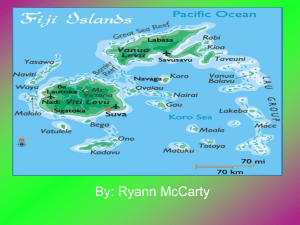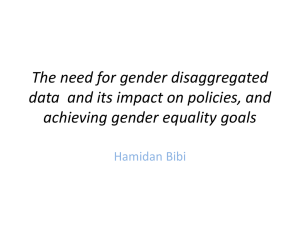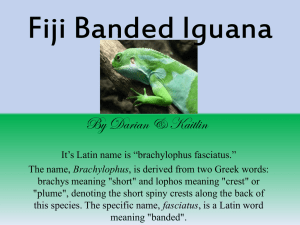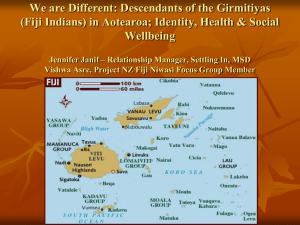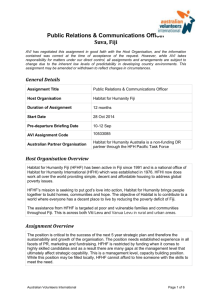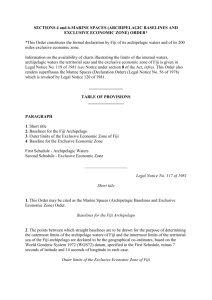Presentation - Pacificidf.org
advertisement
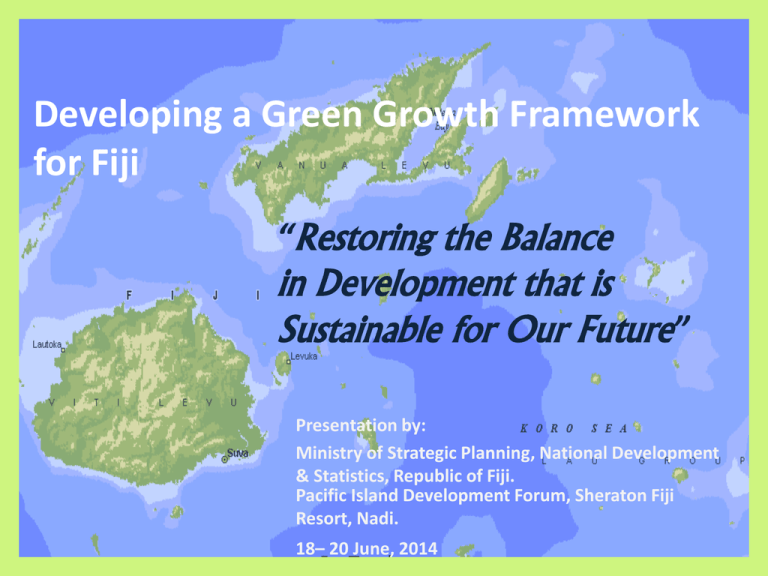
Developing a Green Growth Framework for Fiji “Restoring the Balance in Development that is Sustainable for Our Future” Presentation by: Ministry of Strategic Planning, National Development & Statistics, Republic of Fiji. Pacific Island Development Forum, Sheraton Fiji Resort, Nadi. 18– 20 June, 2014 Outline Part 1: Background & Process Background – International, Regional & National Process to formulate draft Green Growth Framework for Fiji Part 2: An Introduction to the Green Growth Framework for Fiji Vision & Guiding Principles National Enabling Environment Key Thematic Areas Implementation & Monitoring Arrangements Part 3: Conclusion Part 1: Background & Process International commitments… to sustainable development Rio, 1992 Barbados Programme of Action, 1994 Fiji party to international commitments since 1992. Fiji is party to other related international commitments such as the Millennium Summit and MDGs. Rio +10, 2002 Mauritius Strategy, 2005 Rio +20, 2012 Regional commitments…to developing Green Growth tool • 2012, Melanesia Spearhead Group Leaders Meeting MSG •2013 Pacific Small Islands Developing States Regional Preparatory Meeting for PSIDS Samoa 2014 • 2013, Inaugural Pacific Islands PIDF Development Forum National commitments…to frame high level development policies, over past 8 years President’s Mandate, 2007 State of the Nation and Economy Report, 2008 Peoples Charter for Change, Peace & Progress, 2009 Roadmap for Democracy and Sustainable Socio-Economic Development, 2010 Major findings from SNE: Low savings and investment Sharp rise in unemployment and poverty Lack of access to land for productive and social purpose Weakening export base Loss of skilled labour to emigation Declining standard of public service delivery Increasing public debt; and Poor state of infrastructure National commitments…to frame development policies Key Pillars to Rebuilding Fiji: President’s Mandate, 2007 State of Nation and Economy Report, 2008 Peoples Charter for Change, Peace & Progress, 2008 Roadmap for Democracy and Sustainable Socio-Economic Development, 2010-2014 1. Good and Just Governance 2. Common National Identity and Building Social Cohesion 3. Leadership 4. Enhancing Public Sector Efficiency 5. Achieving Higher Economic Growth 6. Making More Land Available for Productive and Social Purposes 7. Developing an Integrated Development Structure at the Divisional Level 8. Reducing Poverty to a Negligible Level by 2015 9. Making Fiji a Knowledge based Society 10. Improving Health Service Delivery 11. Enhancing Global Integration and International Relations. In summary, Fiji’s prerequisites for the future that have been identified to support sustainable development are: Integration Inclusiveness Partnership Ownership Relevance Innovation Consultative process…to develop the Green Growth Framework, 2014 Objective: Refinement and seek broad consensus on draft Framework Seek community perspective on draft Framework 10 working groups, each convened twice, to discuss Baseline Papers and draft Thematic Area sections. Involve all key agencies within Government in process Level of consultation: NATIONAL SUMMIT 400 stakeholders (public sector, private sector, civil society, academia & development partners) involved. PROVINCIAL LEVEL CONSULTATION THEMATIC WORKING GROUPS Key stakeholders (public sector, private sector, civil society) involved. Up to 30 people per Working Group CORE COMMITTEE DESKTOP REVEIW Internal SPO process with inputs received from Ministries Summary • Process initiated by PM Nov, 2013 • Ongoing updating and review Dec 2013 – June 2014 • Formulation & Consultation Process • Monitoring & Evaluation • Seek Cabinet Approval July-Aug, 2014 • Awareness • Advocacy • Translation Implementation Part 2: Green Growth Framework for Fiji “Restoring the Balance in Development that is Sustainable for Our Future” Outline of Framework Chapter 1 – Introduction; Chapter 2 – Vision and Guiding Principles; Chapter 3 – Overview of Socio-Economic and Environmental Development Progress; Chapter 4 – Developing and Strengthening the National Enabling Environment; Chapter 5 – Key Thematic Areas; and Chapter 6 – Implementation and Monitoring Arrangements. * There will be a Foreword and Executive Summary to support Framework Chapter 1 - Introduction Focused on rebalancing 3 pillars of sustainable development (Economic, Social, and Environment. Bring transformational change through: Innovation Integration Inclusiveness Inspiration Investing Environment Economic Social Chapter 2 – Vision & Guiding Principles Vision – “A Better Fiji For All” Guiding principles Reducing carbon footprints at all levels. Improving resource productivity (doing more with less). Move away from ‘sector based’ approach to ‘integrated approach’ Socio-cultural education of responsible environmental stewardship and civic responsibility. Increasing adoption of comprehensive risk management practices Increasing adoption of environmental auditing Structural reform to encourage fair competition and efficiency. Incentivizing investment in efficient use of natural resources. Chapter 3 – Overview of SocioEconomic and Environmental Development Progress Macroeconomic indicators Key social indicators – poverty, unemployment, urbanisation Environmental concerns – waste management, climate change, freshwater resources Chapter 4 – Developing and Strengthening the National Enabling Environment” Partnerships Informed Decision making – need for data Human resource development Governance & Leadership Harness technology Investment – public sector investment & incentivizing private investment Chapter 5 – Key Thematic Areas Environment Social Economic 1. Building Resilience 4. Inclusive Social to Climate Development Change and Disasters 5. Food Security 7. Energy Security 2. Waste Management 9. Technology Innovation and Development 6. Freshwater Resources and Sanitation 3. Sustainable Island Management and Ocean Resources 8. Sustainable Transportation 10. Greening Tourism and Manufacturing Industries Structure of Key Thematic Area Sections INTRODUCTION CURRENT STATUS i) Overview of Existing Policies ii) Review of Performance Key Challenges Way Forward Chapter 6 - Implementation and Monitoring Arrangements Advocacy and Awareness High Level Multi-Stakeholder Panel on Sustainable Development Chaired by PM Cross-Stakeholder Representation Time-bound targets Short-term, Medium-term, Long-term Support Roadmap and its successor Concluding Remarks Continuity of Vision of the Peoples Charter Notable prerequisites to success: - Political Will - Inclusiveness Why Fiji needs to act now – ‘hot spots’. Availability of timely, quality data Implementation Sharing of Fiji’s Experience
